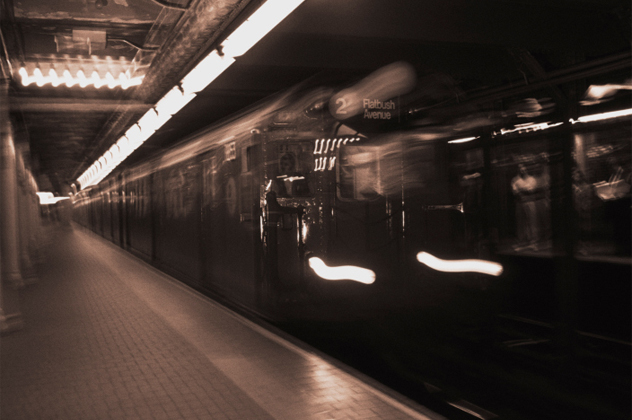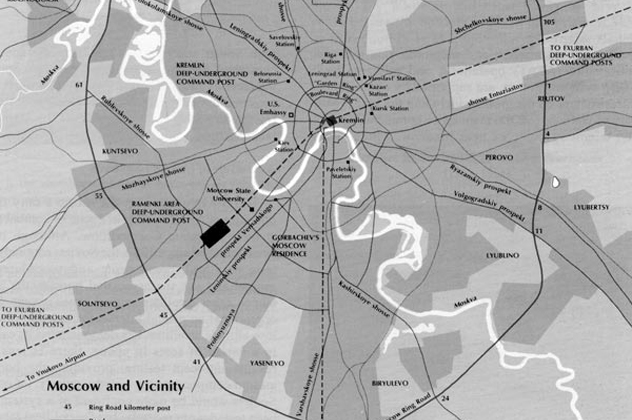Standing on a deserted subway platform is an eerie experience. You stand in the cold darkness for your train, hearing distant creaks and whistles, wondering if every sound is your train pulling in or the tormented screams of the damned. This setting is just the place for creepy mysteries and legends.
独自一人站在空荡荡的地铁站台边上,等待着开往自己目的地的列车,黑暗笼罩着周围的一切,远处飘来地铁疾驰的呼啸声,车身在运行过程中嘎吱作响,这是地铁要进站了吗?还是地狱中的灵魂在哀鸣?地铁站,正是孕育各种奇闻异事的温床。
10.New York Subway's Mysterious DNA
10.来自纽约地铁的神秘DNA

In 2014, a team of scientists from Weill Cornell Medical College sequenced genetic material found in the turnstiles, seats, and ticket booths of all 468 New York City subway stations. They discovered bacteria known to thrive on human skin, as well as those associated with gastrointestinal and urogenital systems and human feces. They discovered remnants of neighborhood-specific cuisine like pizza and falafels, though considering the fecal bacteria situation, eating on the subway might be ill-advised. One station that had been flooded during Hurricane Sandy still contained DNA associated with a marine environment. They even found traces of anthrax and the bubonic plague, although they were also quick to downplay any risks to the public. All in all, the team found DNA from 15,152 distinct species.
2014年,韦尔康奈尔医学院(Weill Cornell Medical College)的科学家研究团队采集了486个纽约地铁站中的验票闸门、座位和自动售票机里的各种细菌基因样本进行排序。他们发现,这些细菌不仅来自人体皮肤,有的甚至来自肠道、泌尿系统以及人的排泄物。他们找到的残余物中还包含地铁站附近特有的美食,例如披萨饼和沙拉三明治。尽管只是残留在排泄物中的细菌,但在地铁上饮食仍然存在染病的风险。其中一个地铁站曾因为飓风桑迪(Hurricane Sandy)的袭击而被洪水淹没,科学家还在那里找到了海洋生物的DNA。甚至还在有些地铁站中找到了炭疽病菌和黑死病杆菌,虽然这些病菌对人们的健康已不会再造成什么威胁。研究团队一共找到了15152个不同类型的DNA。
The weird part? Over half of the DNA sequences matched no known organism. The likely explanation is that the subways simply contain mundane microorganisms that we haven't got around to matching the genetic sequences for yet. Then again, New York's health department condemned the paper, saying, “This report is deeply flawed, and the interpretation of the results is misleading. The researchers failed to offer alternative, much more plausible explanations for their findings, which is a common best practice for scientific papers.” That sounds like they might be hiding aliens.
看到这里你可能想问:“这有什么诡异的?” 别急,待我慢慢道你听。过半数采集到的DNA序列经测试后都无法与已知的有机体进行配对,这也许说明了地铁里存在着很多我们还未进行配对的微生物基因序列。纽约卫生部门对此指责道:“这一报告存在着重大缺陷,而且得出的结论会使公众产生误解。研究人员并不能够提出其他更合乎情理的解释,而充分且合理的验证恰恰是科技论文所要求的。”听起来,是不是有点像地铁里藏着外星人呢。
9.Tokyo's Secret Underground Network
9.东京的秘密地下交通网

In 2002, journalist Shun Akiba published Teito Tokyo Kakusareta Chikamono Himitsu (translated as Imperial City Tokyo: Secret of a Hidden Underground Network), in which he claimed to have uncovered evidence of a secret network of tunnels by comparing historical and modern subway maps. “Close to the Diet in Nagata-cho, current maps show two subways crossing. In the old map, they are parallel.” Convinced that such engineering was impossible, he began to dig into construction records.
2002年,记者秋庭俊(Shun Akiba)在其所撰写的《帝都东京:隐藏在地下的秘密》(日文名为:帝都东京·隠された地下網の秘密,英文译名为Imperial City Tokyo:Secret of a Hidden Underground Network)一书中表示,通过对比新旧的地铁路线图,他已经找到了东京存在秘密地下通道网的证据。他在书中说道:“新版的地铁路线图显示,在永田町的国会大厦附近有两条地铁线路在此交汇。但是在旧版的地铁路线图中,它们却是平行分布的。”他深信基于这样的铁路设计是不可能存在的,于是便开始深入挖掘地铁的建设记录。
This turned out to be only the first of seven riddles which he believes are inconsistent with official records. The others were old maps showing a secret underground complex between Kokkai-gijidomae and the prime minister's residence, maps of the National Diet surrounded by a huge empty space and paddy fields, multiple inconsistencies in newer maps, strange points of interest around postwar Tokyo's General Headquarters, and the possibility that the “new” Oedo line had already existed and the money allocated for tunneling had just disappeared.
根据秋的调查记录表明,这其实只是七个与官方记录前后矛盾的谜团之一。其他的还包括:一、旧版地铁线路图中显示在国会议事堂和总理官邸之间存在着一个复杂的大规模地下建筑;二、战前的地图上显示,国会议事堂地铁站居然建在大片空旷的稻田之上,这个地铁站的地表仍跟以前一样,可新地图上却没有见到这个地铁站的标识,让我们不禁思索“军方隐瞒了什么东西”;三、地铁线在新地图上根本就不连贯,这可能说明“政府仍在继续隐瞒着重大的地下秘密”; 四、日本自卫队在战后修建了一个地下秘密总指挥部,该指挥部所在的地下铁已成为东京最神秘的地方;五、新的大江户线极有可能已经建成,但政府却对外声称准备动工建造;六、原本指定用于挖掘地铁隧道的预算却不明缘由地不翼而飞。
Shun believes that a secret underground network was first built before World War II but is concerned as to why it remains a secret even today, suggesting that it may be part of government preparations for a nuclear attack. Some believe that government officials have access to secret trains and underground complexes beneath government buildings.
秋庭俊提出,该秘密地下交通网在第二次世界大战之前就已竣工,但是为什么政府迄今仍然保持神秘,不对外公开。他推测道,这可能是政府为了进行核攻击而准备的工事。公众中也有人认为,高级政府官员已经在使用国会大厦地下的秘密列车与建筑了。
8.Mole People And Troglodytes
8.鼹鼠人和穴居人

For years, there have been tales of homeless people disappearing into the tunnels of the New York subway system and never emerging again. These alleged mole people were said to be mutants who hated the sunlight and surface dwellers, preferring to live in underground cities built in abandoned train tunnels, where they steal electricity, tap into water pipes, and build their own houses and dwellings. More outlandish versions of the legend painted them as bug-eyed monsters who would kill and eat surface dwellers who strayed into their territory.
多年以来,纽约一直流传着一些无家可归的人消失在地铁隧道并且再也没有出现过的传说。据说这些所谓变种的 “鼹鼠人”(mole people)是非常讨厌阳光和地面的人们,他们更愿意居住在城市地下废弃的地铁隧道里,在那里偷电、取水并搭建自己的房屋和住所。另一种更古怪的传说将他们描绘成巨眼怪物(bug-eye monster),会杀死并吃掉误入其领地的地面居民。
When journalist Jennifer Toth went into New York's tunnels in 1993, she didn't find any mutants. Instead, she found a community of thousands of marginalized people—runaways, the mentally ill, drug addicts, alcoholics, and recluses—living in terrible conditions. This forced the city to respond to a long-ignored problem and attempt to get these people out of the tunnels. These attempts were a mixed success. Video footage from 2010 proved that there were still homeless people living in the tunnels, and later concerns were raised over the fate of those trapped by flooding during Hurricane Sandy.
1993年,记者珍妮弗·托特(Jennifer Toth)进入纽约的地铁隧道中一探究竟。在那里她并没有发现任何变种人,相反,她发现了由成千上万脱离社会的人组成的社区。那里的生活条件恶劣,离家出走的、患有精神病的、吸毒的、酗酒的和隐居的人都聚集在一起。这样的情况迫使城市不得不处理这个长期被忽视的问题,政府于是便试图把这些人从隧道中驱赶出去。措施的实施结果成败参半,根据2010年的视频片段显示,仍然有一些无家可归的人在隧道中居住,这些人在飓风桑迪(Hurricane Sandy)袭击纽约的期间,面临被洪水围困的命运时,才得以被关注。
Meanwhile, in London there have long been rumors of devolved humans known as troglodytes living in the Underground, said to be descended from Irish laborers trapped during construction in the 1890s. They are said to survive by eating discarded food, rats, and the occasional unlucky tramp.
与此同时,在伦敦一直流传着有些人会像穴居人(troglodyte)一样在地下生活的谣言,据说他们是19世纪90年代在施工期间被困在地下的爱尔兰劳工后裔。为了生存,他们迫不得已要吃被人们丢弃的食物、老鼠和不太幸运的流浪汉。
7.Singapore Mass Rapid Transit's Bad Feng Shui
7.新加坡地铁的坏风水

In the 1970s, Prime Minister Lee Kwan Yew pushed for the construction of a subway system called Singapore Mass Rapid Transit (SMRT) as part of the city-state's modernization drive. The project began well, but soon the economy began to tank. According to urban legend, Prime Minister Lee visited a feng shui master named Reverend Hong Chuan. Lee was advised that the SMRT network was disrupting the eight dragon veins beneath the city, unleashing angry dragon spirits and/or disrupting the flow of qi, thereby causing the economic downturn.
在19世纪70年代,新加坡总理李光耀(Lee Kwan Yew)力推建设本国的地铁系统,即新加坡地铁(SMRT),并将其作为城市现代化建设中的一个项目。该项目开始时一切都很顺利,不久,经济开始下滑。据都市传说记载,李总理拜访了一位风水大师,也就是当时光明山普觉禅寺的住持:宏船法师(Reverend Hong Chuan)。进而得知导致经济衰退的原因是地铁工程破坏了城市底下的八条龙脉,引起了龙怒和(或)破坏了这里的气场。
The solution was to make all Singaporeans, regardless of their ethnic origin or beliefs, carry a bagua, an octagonal mirror said to deflect negative energy in Chinese geomancy. The alleged solution of how to get the city's diverse population of Chinese, Malays, Indians, and Europeans—of many different faiths—to carry a Chinese geomantic bagua was ingenious. The 1987 Singapore $1 coin was designed with an octagon on both sides, which some believe quelled the dragon spirits and allowed Singapore to embark on a new period of economic growth. The coin was released in September 1987, two months before the grand opening of the first SMRT line at Toa Payoh.
解决的方法是,不论种族和信仰,所有的新加坡人都要随身携带一个“八卦”(bagua)。中国的风水学表明,这个八角形的镜子可以驱散煞气。这个传说中的解决方案非常巧妙地令来自中国、马来西亚、印度和欧洲等各国不同城市不同信仰的人都随身携带了“八卦”。 1987年新加坡重新设计1元硬币,在正反两面都印上一个八边形,许多人认为这样做能够平息龙魂,让新加坡迎来一个新的经济增长期。同年九月,新设计的1元硬币在国内正式发行。两个月后,第一条地铁线路在大巴窑镇(Toa Payoh)隆重启动。
6.莫斯科地铁2号线

People have been hiding things beneath Moscow for centuries: Byzantine libraries, Ivan the Terrible's secret torture chamber, and Catherine the Great's underground canal network. So it's unsurprising that Stalin got in on the action. Metro-2 is the name given to a purported secret underground rail network built by Stalin in the 1930s to allow the Soviet secret police to move around the city rapidly without detection. It originally linked Stalin's dacha (suburban residence), the Ministry of Defense, command bunkers, and other military facilities. Larger and more extensive than the official metro system, it is unknown whether construction stopped after Stalin's death or if his successors continued to expand it.
几个世纪以来,人们已在莫斯科地下藏了不少东西:拜占庭图书馆(Byzantine libraries)、伊凡雷帝(Ivan the Terrible)的秘密酷刑室和凯瑟琳大帝(Catherine the Great)的地下通道网,所以斯大林也想加入他们的行列也就不足为奇了。地铁2号线,指的是斯大林在20世纪20年代所建造的秘密地铁网,可供苏联秘密警察在城市里不受监视地快速自由通行。这条地铁线路一开始是连接斯大林郊外的别墅、国防部、总参谋部和其他军事机构的地下通道,比官方向公众展示的地铁系统更大、更宽。在斯大林去世后,该工程的建设是停止了抑或是仍由其继任者继续扩建就不得而知了。
The system was also meant to serve as protection against nuclear attack, with a supposed giant bunker built beneath the Moscow suburb of Ramenki that was able to house up to 300,000 people along with an alternate command post for the Soviet high command. There are even rumors that the network extends for miles outside Moscow, allowing Soviet leaders to flee in case the capital was hit by a nuclear attack. There are also rumors that the tunnels were used by the military to transport supplies, materials, and personnel between bunkers without exposure.
该地铁线路还是一个能在国家受到核攻击时给国民提供庇护的场所。人们认为有一巨型堡垒位于莫斯科的郊区拉缅基(Ramenki)底下,可容纳的人数高达30万,同时还是苏联最高指挥部的预备指挥中心。甚至有传言说,该地网延展到莫斯科以外数英里,以便苏联领导们在首都遭到核导弹攻击时逃跑。还有传闻声称,军队可以利用该隧道在地堡间秘密运送物资、材料和人员。
A tunnel leading into the Metro-2 system was discovered after the 1960s-era Rossiya Hotel near the Kremlin was demolished. The tunnel was referred to as “D6,” which is apparently KGB code for Metro-2, and urban explorers attempted to exit to the main metro line through a sealed door.
在20世纪60年代,克里姆林宫(Kremlin)附近的罗西亚酒店(Rossiya Hotel)被拆毁之后,人们发现了一条通往地铁2号线的隧道,其名称为“D6”,这显然是当时苏联国家安全委员会(KGB)给地铁2号线起的代号。人们曾想利用“城市探险者”通过一扇焊死的门离开地铁2号线并进入地铁正线。
审校:王大 校对:CMX 编辑:旭旭 来源:前十网
















